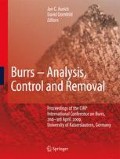Abstract
Reducing burr formation in machining operations is of vital importance as they can decrease the functionality of components and can cause injuries. Nowadays, additional processes for deburring are often necessary. To avoid deburring, the modification of machining processes is a promising approach. Here, different parameters have a significant influence on burr formation. For example, the use of alternative machining processes or the reduction of the workpiece temperature near the edge of the workpiece shows high potential for burr reduction. This temperature reduction causes a change in material properties which decreases burr formation. In this paper, methods for burr minimization in various cutting processes are presented. Burr reduction strategies for turning, drilling and milling of different materials are presented.
Access this chapter
Tax calculation will be finalised at checkout
Purchases are for personal use only
References
Agrawal, S., Chakrabarti, A., Chattopadhyay, K. A. B., 1995, A Study on the Machining of Cast Austenitic Stainless-Steels with Carbide Tools. Journal of Materials Processing Technology, 52: 610–620
Schoß, V., 2001, Martensitische Umwandlung und Ermüdung austenitischer Edelstähle – Gefügeveränderungen und Möglichkeiten der Früherkennung von Ermüdungsschäden, Dissertation Technische Universität Bergakademie Freiberg
Buschka, M., 2002, Formgedächtnistechnik – Prozessgestaltung beim Drehen und Bohren von NiTi-Formgedächtnislegierungen, Dissertation Universität Dortmund
Hesterberg, S., 2006, Trockenbearbeitung nichtrostender Stähle. Prozessauslegung für das Drehen und Bohren mit Wendeschneidplatten, Dissertation Universität Dortmund
Weinert, K., Kersting, M., 2007, Schneesturm vermindert Gratbildung. Technica, 3: 30–32
Weinert, K., Kempmann, C., 2005, Comparing Drilling and Circular Milling for the Drill Hole Manufacture of Fiber Reinforced Composites, Production Engineering – Production Engineering, Annals of the German Academic Society for Production Engineering, Vol. XII(2): 1–4
Weinert, K., Hammer, N., 2004, Zirkularfräsen von Bohrungen im Leichtbau. WB Werkstatt und Betrieb, Industrielle Metallbearbeitung, 10: 54–58
Hammer, M., 2007, Spanende Bearbeitung endlos stahlverstärkter Aluminiummatrixstrangpressprofile, Dissertation Universität Dortmund
Kahn, H., Huff, M. A., Heuer, A. H., 1998, The TiNi-shape-memory alloy and itds applications for MEMS, Journal of Micromechanics and Microengineering, 8: 212–221
Machado, L. G., Savi, M. A., 2003, Medical applications of shape memory alloys, Brazilian Journal of Medical and Biological Research, 86: 683–691
Petzold, V. 2006, Formgedächtnistechnik – Tiefbohren und Mikrofräsen von NiTi, Dissertation Universität Dortmund
Weinert, K., Petzold, V., 2006, Micromachining of NiTi Shape Memory Alloys, Production Engineering – Production Engineering, Annals of the German Academic Society for Production Engineering, Vol. XIII, 2: 43–46
Acknowledgements
The authors acknowledge funding by the German Research Foundation (DFG) for several research projects.
Author information
Authors and Affiliations
Corresponding author
Editor information
Editors and Affiliations
Rights and permissions
Copyright information
© 2010 Springer-Verlag Berlin Heidelberg
About this paper
Cite this paper
Biermann, D., Heilmann, M. (2010). Burr Minimization Strategies in Machining Operations. In: Aurich, J., Dornfeld, D. (eds) Burrs - Analysis, Control and Removal. Springer, Berlin, Heidelberg. https://doi.org/10.1007/978-3-642-00568-8_2
Download citation
DOI: https://doi.org/10.1007/978-3-642-00568-8_2
Published:
Publisher Name: Springer, Berlin, Heidelberg
Print ISBN: 978-3-642-00567-1
Online ISBN: 978-3-642-00568-8
eBook Packages: EngineeringEngineering (R0)

